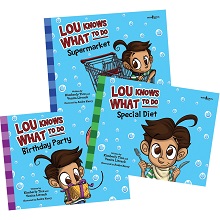Effective Autism Intervention: Teaching "What to Do"
Posted by Kimberly Tice and Venita Litvack, CCC-SLP and Boys Town Press Authors on Apr 2nd 2020
Excerpts taken from full article originally featured in Teach Magazine.

Consider this: You are driving in traffic, it starts raining, and you can barely see in front of you. Your music is blasting so you turn it down to focus on driving. Your brain can only process so much sensory input at a time. In this scenario, your visual and auditory sensory systems are overloaded so you eliminate one (auditory) to focus on the other. This is what it is like for someone with autism who has difficulty processing sensory information—even in everyday environments. Imagine how that can be amplified for someone who does not know why it is happening or how to communicate how he or she is feeling. This can often lead to anxiety and an undesirable response.
The newest studies will tell you that 1 in 68 children born now have autism. This is a jaw-dropping increase from the statistics dating from the year 2000, when the CDC reported autism occurring in only 1 of 150 births. According to the Autism Society, this is the fastest growing developmental disability, with about one percent of the world’s population currently having a diagnosis. Autism is typically diagnosed at around age two or three when children present with repetitive behaviors and delays in social skills. The severity of these delays varies. While communication deficits are always part of the cause for an autism diagnosis, they vary greatly from child to child, as do sensory processing issues and behaviors. These individuals also present with a unique range of strengths and weaknesses—it is often said that if you meet one child with autism, you have met just one.
Adjusting to a variety of social scenarios is just one portion of intervention. What other skills do educators and speech language pathologists (SLPs) have to teach? Some lessons include: maintaining personal space, initiating conversation, making eye contact, maintaining conversational topics, using socially appropriate phrases, speaking at an acceptable volume, requesting clarification when confused, and more. How are these lessons taught? Visuals and social stories really come in handy. Since a range of communication deficits are present in persons with autism, auditory processing may be impaired and verbally talking about these concepts may not be enough. Teachers and SLPs help educate children with autism and other disabilities to improve their communication skills and learn what to expect in new environments. Teaching appropriate social skills is an integral part of effective autism intervention. This is difficult because “social skills” are not a straightforward lesson. For example, your behavior at a friend’s party is probably much different than at a work function, or a library, or a funeral. Since an effective communicator knows how to “code-switch” or change his or her behaviors as needed, with hardly a second thought, this isn’t an issue. This is not the case for a person with autism.
Social stories have been proven an effective form of intervention. Pairing lessons with visuals in the stories helps to solidify concepts for children. Stories don’t just suggest appropriate behaviors, they also describe different settings and social scenarios so that children know what to expect. These stories can be revisited to help the students internalize this knowledge and become more comfortable with new surroundings or situations, which leads to a reduction in negative behaviors.
Along with the rise in autism rates, awareness for autism has also increased. Now the entire month of April is dedicated to autism awareness, with mainstream audiences paying attention. A few years ago, Autism Speaks started a “Light it Up Blue” campaign. Many major cities and well-known businesses proudly display lights on skyscrapers and other popular establishments to bring attention to the cause. Popular children’s shows, including Sesame Street, have added characters with autism to help children understand some of the behaviors people with autism spectrum disorder (ASD) can exhibit. Julia, the newest character on Sesame Street, can sometimes have sensory-related behaviors and difficulty communicating, raising awareness of ASD among millions of children. This has helped kids understand that Julia isn’t misbehaving and still deserves friends, kindness, and compassion.
Resources like TV shows and books that many parents take for granted are much harder to come by for kids on the autism spectrum. Although Julia is a great start to raising more ASD awareness within the mainstream media, there is still a need for more distinct books and other entertainment featuring people with autism and also written for the ASD population. It is also important to find literature that will help students display empathy when they witness some difficult moments their ASD peers are experiencing during the school day. Some books directly speaking about social skills could also benefit children with and without autism. After all, if we want to see expected behavior, we must teach it.

Due to the lack of published materials available, teachers and SLPs spend much time preparing therapeutic tools and generating individual social stories to meet their students’ needs. While working in our office at the Palm Beach School for Autism, we started wondering why no one published more books to teach social skills and expectations in different scenarios. It was here that the idea for Lou Knows What to Do was born. Our research determined that few books existed to address social skills. Of the ones that were published and available to the general public, many addressed specific behaviors (i.e., not hitting friends) and none seemed to target specific events, such as birthday parties. So we started meeting on the weekends to make the Lou project come to life so that he could share “what to do” with as many children as possible. We wanted to create a therapeutic tool to help parents utilize the stories the same way teachers and therapists do in lessons. So we added comprehension questions and a parent guide for optimal use.
Get the Lou Knows What to Do books here.
For Autism Awareness Month, we've put together some other resources as well.
